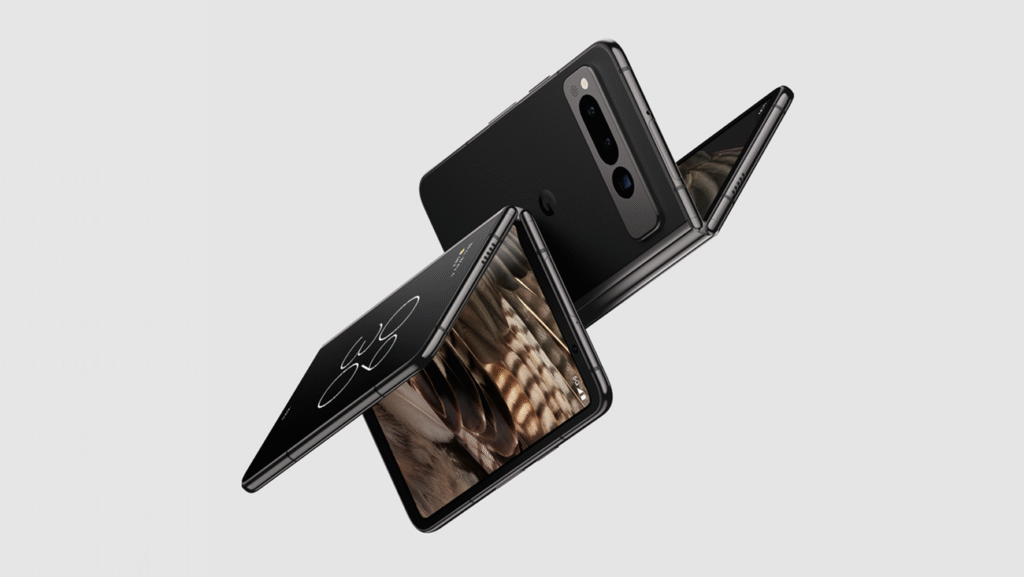After years of dominating smartphone photography with software smarts and establishing a distinct design language with the Pixel 6 and 7 series, Google took a bold leap into a new category in the summer of 2023: the foldable market. The Google Pixel Fold wasn’t just Google’s first foldable; it was a statement piece, showcasing the company’s hardware engineering prowess and its vision for how Android should adapt to larger, flexible screens. It also came with a hefty $1799 price tag, placing it firmly in the ultra-premium segment.
Design: Passport Form Factor, Premium Build

The Pixel Fold adopted the book-style folding format but with a distinct Google take:
- Wider Aspect Ratio: Unlike some competitors with tall, narrow outer screens, the Pixel Fold featured a 5.8-inch outer display with a wider 17.4:9 aspect ratio. When closed, it felt more like holding a traditional phone or a small passport, making typing and using apps on the cover screen very comfortable.
- Thin When Open: Unfolded, it revealed a spacious 7.6-inch inner display. Impressively, Google engineered the Fold to be exceptionally thin when open (around 5.8mm), making it one of the thinnest foldables available at launch.
- Custom Hinge: Google highlighted its custom-built stainless steel hinge, designed for durability, smoothness, and the ability to fold completely flat without a gap – a feat not all foldables achieved at the time.
- Premium Materials: The device used Gorilla Glass Victus on the outer screen and back, paired with a polished aluminum frame, giving it a decidedly premium feel. It launched in two colors: Obsidian (black) and Porcelain (white).
- Water Resistance: It boasted an IPX8 rating, meaning it could handle submersion in water, though like most foldables, it lacked an official rating for dust resistance due to the complexities of the hinge.
- Bezels & Biometrics: The inner screen featured noticeable bezels, particularly at the top and bottom, which housed the inner selfie camera. The fingerprint sensor was cleverly integrated into the power button on the side, and convenient (though less secure) Face Unlock was also available.
Hardware: Familiar Power, Dual Screens
The Pixel Fold leveraged the proven performance of Google’s second-generation custom chip:
- Google Tensor G2: The same powerful and AI-focused Tensor G2 chip found in the Pixel 7 series powered the Fold, ensuring smooth performance and enabling Google’s signature software features.
- RAM & Storage: Came equipped with a generous 12GB of LPDDR5 RAM and offered 256GB or 512GB of fast UFS 3.1 storage.
- Dual High-Refresh Screens: Both the 5.8-inch outer and 7.6-inch inner OLED displays featured smooth 120Hz refresh rates for fluid scrolling and animations.
- Battery & Charging: A 4821mAh battery provided respectable all-day endurance. The Fold supported wired charging (around 21W) and Qi-compatible wireless charging.
- Security: Included the Titan M2 security chip.
Cameras: A High-End Foldable System
Google aimed to bring a strong camera experience to its foldable, using a versatile triple-lens rear setup:
- Rear Cameras: A 48MP main camera (f/1.7, OIS) led the charge, joined by a 10.8MP ultrawide (121° FOV) and a capable 10.8MP telephoto lens with 5x optical zoom and OIS. While sensors differed slightly from the Pixel 7 Pro, the overall quality was excellent thanks to Google’s processing.
- Selfie Cameras: A 9.5MP camera was on the outer screen, and an 8MP camera was housed in the inner screen’s bezel.
- Foldable Advantages: Users could leverage the foldable design for better photos, using Rear Camera Selfie mode (using the superior main cameras for selfies with the outer screen as a viewfinder) or Tabletop mode (folding the phone partway to act as its own tripod).
- AI Features: All the expected Pixel camera magic, powered by Tensor G2, was present: Night Sight, Portrait Mode, Real Tone, Photo Unblur, Magic Eraser, Super Res Zoom, etc.
Software: Optimized for the Fold
Launching with Android 13, the Pixel Fold featured numerous software optimizations designed for the larger, flexible display:
- Taskbar & Split Screen: A persistent taskbar allowed for quick app switching and easy drag-and-drop multitasking in split-screen mode. Many Google apps were optimized to take advantage of the larger canvas.
- Screen Continuity: Apps seamlessly transitioned between the outer and inner screens when folding or unfolding.
- Dual Screen Modes: Features like the interpreter mode in Google Translate could show translations on both screens simultaneously, facilitating face-to-face conversations.
- Update Promise: Google committed to 3 years of OS updates and 5 years of security updates for the Fold (support ending June 2026 and June 2028, respectively).
Reception and Legacy: A Strong First Fold
The Google Pixel Fold received generally positive, albeit sometimes mixed, reviews. Its excellent, highly usable outer screen, impressively thin design when open, smooth hinge mechanism, strong camera performance, and smart software optimizations were widely praised. It proved Google could compete seriously in the demanding foldable space right out of the gate.
Criticisms often centered on the premium $1799 price tag, the noticeable bezels around the inner screen, typical foldable durability concerns (particularly regarding the inner screen’s plastic layer), and the Tensor G2 chip lagging slightly behind the absolute latest Snapdragon processors in raw benchmarks. However, as a first-generation foldable, the Pixel Fold was seen as a remarkably polished and thoughtfully designed device that successfully translated the Pixel experience into an exciting new form factor.
